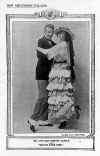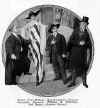History of The Musical Stage
1910-19 Part II: Revues
by John Kenrick
(Copyright 1996; revised 2020)
(The images below are thumbnails – click on them to see larger versions.)
Irving Berlin
 Vernon
and Irene Castle were the most popular dance team of the 1910s,
initiating various dance and fashion crazes. Here they are seen in the original program to Watch
Your Step (1914).
Vernon
and Irene Castle were the most popular dance team of the 1910s,
initiating various dance and fashion crazes. Here they are seen in the original program to Watch
Your Step (1914).
In 1911, former Bowery waiter Irving Berlin's vaudeville song "Alexander's Ragtime Band" became an international sensation, igniting a worldwide craze for the all-American sound of syncopation. Without warning, America was suddenly setting the pace and rhythm of popular music for the whole world, and the waves of change emaneted in New York.
Most of New York's music publishers had offices on a three block stretch of West 28th Street, where the din of pianists at work was compared to housewives banging tin pans, earning that area and the music publishing industry the nickname Tin Pan Alley.
Berlin had already contributed individual songs to various revues and vaudeville acts. He created his first complete stage score for producer Charles Dillingham's "syncopated revue" Watch Your Step (1914 - 175 performances). Unlike most revues, it had a wisp of a plot -- librettist Harry B. Smith's program credit read "Book (if any)" -- involving a young man and woman competing to win an inheritance by each proving they had never been in love, and (of course) falling in love as they spend a day wandering about Manhattan.
Watch Your Step was designed as a showcase for the most popular dance team of the era, real life husband and wife Vernon and Irene Castle. The Castle's brought a modern sense of intimacy and humor to ballroom-style dancing, making them the perfect choice to bring Tin Pan Alley syncopation to Broadway. Berlin's jaunty counterpoint ballad "Play a Simple Melody" became a standard, and the Castle's turned his "Syncopated Walk" into a show stopper.
Berlin found this success so satisfying that he turned out scores for several more revues, including the songs "I Love A Piano" for Stop! Look! Listen! (1915) and "A Pretty Girl is Like a Melody" for The Ziegfeld Follies (1919). Although Berlin was initially more interested in writing hit songs than in creating great theater, he continued writing for Broadway revues and book musicals into the 1960s. There is far more on him in the pages ahead.
Scandals and Vanities
 The
Passing Show of 1913 offered chorus girls cascading
down a stage-wide staircase. A serious Follies competitor, this twelve year
series is rarely mentioned today.
The
Passing Show of 1913 offered chorus girls cascading
down a stage-wide staircase. A serious Follies competitor, this twelve year
series is rarely mentioned today.
Ziegfeld's Follies (discussed in detail on our next page) were generally considered the best revues of this era, but there were several major competing series in the 1910s and 1920s –
– George White was a featured dancer in the 1911 and 1915 editions of the Follies. Confident that he could improve on Ziegfeld's approach, White produced a series of thirteen lavish Scandals between 1919 and 1939. With music, comedy, beautiful chorus girls and top-quality dance routines, White's revues were so popular that they made Ziegfeld uneasy. White demanded better scores than Ziegfeld. His Scandals introduced such lasting hits as George and Ira Gershwin's "Stairway to Paradise" and "Somebody Loves Me," as well as DeSylva, Henderson and Brown's "Birth of the Blues," "The Black Bottom" and "Life is Just a Bowl of Cherries." The Scandals' roster of stars included Rudy Vallee, Harry Richman, Ethel Merman and former Follies dancer Ann Pennington. White moved on to Hollywood and filmed several Scandals, but drifted into obscurity after the 1940s.
– Director John Murray Anderson initiated The Greenwich Village Follies, an intimate downtown revue that proved so popular that it had to be moved to Broadway. Displaying Anderson's masterful gift for inventive, stylish staging, this series had eight successful editions between 1919 and 1928, becoming bigger and more elaborate each year. Anderson soon left the series but remained an important stage director, helming two editions of the Follies after Ziegfeld's death. His New Faces of 1952 (1952 - 365 performances) and Almanac (1953 - 229 performances) won acclaim long after the Broadway revue had been dismissed as a dead genre.
Raunchier Options
 Long
before Saturday Night Live, presidential
candidates took their comic licks from Broadway revues. Here actors portraying
presidential candidates Woodrow Wilson, Theodore
Roosevelt and Senator Charles Evans Hughes seek the hand of "Miss
Nomination" in The Passing Show of 1916.
Long
before Saturday Night Live, presidential
candidates took their comic licks from Broadway revues. Here actors portraying
presidential candidates Woodrow Wilson, Theodore
Roosevelt and Senator Charles Evans Hughes seek the hand of "Miss
Nomination" in The Passing Show of 1916.
– In a blatant attempt to copy the success of the Follies, theatre owners Lee & Jacob Shubert presented lavish revues at their new Winter Garden Theatre. After several false starts, they launched The Passing Show, a series that ran occasionally from 1912 to 1924. The Shuberts used underpaid staff writers and designers to turn out shows that were short on style but packed with almost-naked chorus girls. The Passing Show also boasted a stellar line-up of performing talent, including comics Willie and Eugene Howard, Ed Wynn, DeWolf Hopper, Adele and Fred Astaire, Charles Winninger, and future Ziegfeld star Marilyn Miller. The most memorable songs from the series included "Smiles" and "I'm Forever Blowing Bubbles." When the Shuberts decided they could make more money by setting their sights even lower, The Passing Show became the first major revue series to fade away.
– Convinced that female nudity was enough to sell a revue, Jacob Shubert produced a series entitled Artists and Models. During rehearsals, Shubert ripped material off the chorus girls' costumes until he felt sufficient flesh was showing. The resulting displays drew so much condemnation in the press that curious audiences packed the theatre for three profitable editions (1923-1925).
– Earl Carroll was a minor songwriter and colorful ladies man who produced a series of popular Vanities and Sketchbooks between 1923 and 1940. He didn't settle for under-dressing his chorus girls – he often presented them stark naked, defying the law and garnering tremendous publicity. Carroll had a taste for bawdy comedy acts that would never have been allowed in a Ziegfeld show. Carroll's stars included Joe Cook, Sophie Tucker, W.C. Fields, Jack Benny and Milton Berle. Carroll's racy private life and outrageous publicity stunts landed him in jail on several occasions. When the Great Depression killed off lavish stage revues in the 1930s, he opened a popular Hollywood nightclub and produced several successful films before dying in a 1948 plane crash.
Most Broadway revues of this period were content to offer large numbers of underdressed women, with just enough comedy to keep audiences awake between lavish production numbers. With a few exceptions, most of the songs in these revues were forgettable.
The popularity of revues took off during the 1910s thanks to Ziegfeld's Follies -- which made the transition from success story to theatrical legend during this decade. . .
